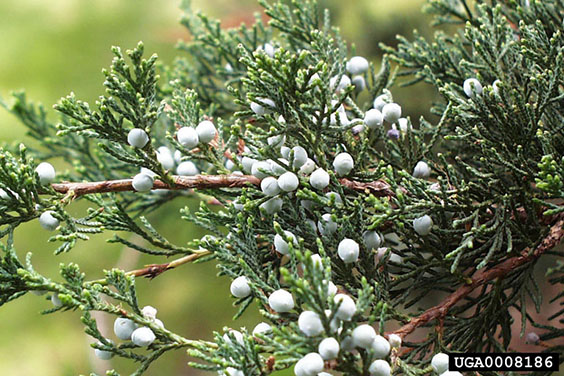
NATIVES TO KNOW
Eastern Red Cedar – Juniperus virginiana
Compiled by Joyce Tuharsky

The Eastern Red Cedar is not a true cedar. It is a juniper, and the most widely distributed native conifer east of the U.S. Rockies. It also occurs in Oregon. Other common names for this tree include: Virginia juniper, Eastern juniper or simply Red cedar.
Rarely exceeding 50 feet in height, this tree has a single trunk and is the only native juniper that is upright and columnar. The bark is reddish-brown, fibrous, and peels off in narrow strips. The leaves are arranged in opposite pairs or occasionally in whorls of three. The leaves are of two types: sharp, spreading needle-like juvenile leaves (up to 1/2 inch), and tightly pressed scale-like adult leaves (1/8 inch). The seed cones are berry-like, dark purple-blue, with a white wax cover. Red cedars are usually dioecious with pollen and seed cones on separate trees. The tiny pollencones shed pollen in late winter or early spring.
The Eastern red cedar is very well adapted to dry areas and is considered a “pioneer species.” Often, they are the first trees to grow in cleared areas where the seeds are spread by cedar waxwings and other birds that enjoy the fleshy seed cones. In fact, the fruit is an important winter food for many birds and mammals, both large and small. The twigs and foliage are browsed extensively by hoofed mammals. Red cedars are also a favorite nesting and roosting site for robins, juncos, warblers, and various sparrows. The tree provides especially valuable wildlife shelter in the winter because of its dense foliage.
In some areas, red cedars are considered invasive, even if native. They will overtake grasslands or prairies if left unchecked. Fire intolerant, red cedars are often eliminated by prescribed burnining. They can burn very quickly. The low branches near the ground catch fire and provide a ladder that allows fire to engulf the entire tree. Dense stands of red cedar have been blamed for the rapid spread of wildfires in drought stricken areas.
The Eastern red cedar was important to many Native American tribes. Various parts of the tree were used in purification rites and for medicinal uses. The durable wood was used for lance shafts, bows, flutes, and canoes parts. Cedar boughs were used for bedding; and the bark was woven into mats for roofing, flooring, or wrappings. In the south, cedar poles were used to mark out hunting territories. In fact, “Baton Rouge” is French for “red stick”—named after the reddish color of these poles.
Today, the close-grained wood of the Eastern red cedar is used for furniture and interior paneling. Because the wood is rot resistant even in contact with soil, it is often used for fence posts. The aromatic oil from the cedar fruits and young branches is used in medicines. Cedar closets and chests protect clothing from moths. Because cedars can be planted in tightly spaced rows and still grow to full height, they create good windbreaks in a short time.
Generally propagated by cuttings, this hardy tree thrives in both drought and cold conditions; and grows well in rocky, sandy, and clay soils. Long-lived, the oldest red cedar was reported in West Virginia at 940 years old!
For more information:
usda.gov/plantguide/ERedCedar.pdf
thoughtco.com/eastern-red-cedar
wildflower.org/plants-RedCedar
